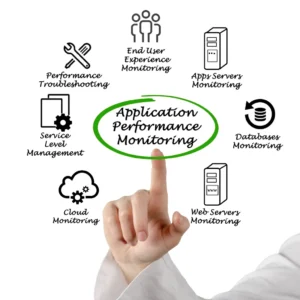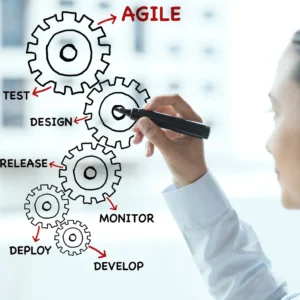
Fostering Excellence
A Comprehensive Guide to Continuous Improvement in Intelligent Process Automation (IPA) Initiatives
Embracing the era of digital transformation, businesses today leverage Intelligent Process Automation (IPA) to streamline operations and boost efficiency.
This article delves into the heart of organizational evolution, focusing on the critical theme of “Continuous improvement in Intelligent Process Automation (IPA).”
As businesses increasingly rely on automation to drive productivity, perpetual enhancement becomes paramount. We will navigate through strategic frameworks, performance metrics, user feedback mechanisms, and other integral facets, unravelling a comprehensive guide to fostering a culture of continuous improvement.
From the synergy of human-in-the-loop adaptations to the ethical governance of automation, each aspect contributes to refining IPA initiatives.
Join us in exploring how organizations can orchestrate a harmonious symphony of human ingenuity and technological precision for the ongoing advancement of Intelligent Process Automation.
Continuous Improvement Frameworks
Elevating Intelligent Process Automation (IPA) Through Continuous Improvement Frameworks
Continuous improvement in Intelligent Process Automation (IPA) is essential for optimizing business processes and ensuring sustained efficiency gains. Organizations are adopting robust continuous improvement frameworks to drive progress in IPA initiatives. These frameworks serve as blueprints, guiding the refinement and enhancement of automation processes over time.
One essential approach involves adapting well-established methodologies like Lean or Six Sigma to suit the unique challenges of automation processes. Traditionally applied to eliminate waste and enhance efficiency, Lean principles seamlessly align with IPA goals. Organizations can enhance IPA performance by identifying and removing redundancies, inefficiencies, and bottlenecks in automated workflows.
Similarly, Six Sigma’s data-driven methodology is invaluable in ensuring the precision and accuracy of automated tasks. Organizations can identify variations, optimize resource utilization, and enhance overall process quality by applying statistical analysis to IPA processes. This integration of Six Sigma into IPA ensures the reliability of automated outputs and contributes to continuous improvement by pinpointing areas for refinement.
Establishing these continuous improvement frameworks empowers organizations to proactively address challenges, adapt to evolving business needs, and maximize the long-term benefits of Intelligent Process Automation. As IPA becomes increasingly integral to organizational workflows, the synergy of proven methodologies and tailored frameworks becomes a linchpin for sustained success in automation initiatives.
Performance Metrics for Continuous Improvement
Optimizing Automation Excellence: Performance Metrics in Continuous Improvement for Intelligent Process Automation (IPA)
Continuous improvement in Intelligent Process Automation (IPA) hinges on meticulously defining and measuring key performance indicators (KPIs). Establishing relevant metrics is paramount to assessing automation initiatives’ effectiveness, ensuring they align with organizational objectives and contribute to overall efficiency.
Defining clear KPIs allows organizations to quantifiably evaluate various aspects of automation workflows, such as processing speed, error rates, and resource utilization. This clarity enables a targeted approach towards areas requiring improvement, fostering a proactive and strategic enhancement of IPA processes.
Moreover, utilizing data-driven insights is pivotal in the continuous improvement journey. Organizations harness the power of analytics to gain a comprehensive understanding of automation performance. By scrutinizing data, they can identify patterns, detect anomalies, and pinpoint bottlenecks, facilitating informed decision-making for process optimization.
The synergy between well-defined performance metrics and data-driven insights creates a feedback loop that propels continuous improvement in IPA. As organizations adapt to evolving business landscapes, leveraging these metrics ensures the ongoing success of automation workflows and positions them to stay at the forefront of innovation in the realm of Intelligent Process Automation.
User Feedback Mechanisms
Enhancing Intelligent Process Automation (IPA) Through User-Centric Feedback Mechanisms
Implementing robust user feedback mechanisms fortifies continuous improvement in Intelligent Process Automation (IPA). These mechanisms are invaluable for gathering insights from end-users and stakeholders, fostering a collaborative approach to refining and optimizing automation processes.
Organizations gain a nuanced understanding of the user experience within automated workflows by actively seeking and analyzing user feedback. This real-time input allows for identifying pain points, user preferences, and areas requiring refinement. Incorporating these insights into the iterative enhancement process ensures that IPA aligns closely with user expectations and operational needs.
User feedback mechanisms contribute to immediate process improvements and lay the groundwork for sustained success. The iterative nature of incorporating user insights enables organizations to adapt IPA to evolving user requirements and business dynamics, fostering a user-centric automation environment. Ultimately, by prioritizing user feedback in the continuous improvement cycle, organizations can elevate the efficiency and user satisfaction levels of Intelligent Process Automation.
Agile Iterative Development
Agility Fuels Progress: Iterative Development in Continuous Improvement for Intelligent Process Automation (IPA)
Continuous improvement in Intelligent Process Automation (IPA) thrives on applying agile development principles, fostering iterative and incremental enhancements to automation workflows. Organizations increasingly embrace the agile methodology to adapt swiftly to evolving business needs and ensure optimal performance in their IPA initiatives.
By employing regular sprints, organizations break down the continuous improvement process into manageable iterations, allowing for focused enhancements in specific aspects of automation workflows. These sprints enable quick adaptation to changing requirements, immediate issue resolution, and the incorporation of emerging technologies.
Agile, iterative development aligns seamlessly with the dynamic nature of IPA, promoting a flexible and responsive approach to automation evolution. The methodology empowers teams to prioritize and address critical features, ensuring that each iteration contributes meaningfully to the overall advancement of Intelligent Process Automation. In embracing agile principles, organizations enhance the efficiency of their automation processes and cultivate a culture of adaptability and continuous growth within their IPA initiatives.
Root Cause Analysis for Issues
Unveiling Efficiency: Root Cause Analysis in Continuous Improvement for Intelligent Process Automation (IPA)
A pivotal aspect of continuous improvement in Intelligent Process Automation (IPA) is the implementation of rigorous root cause analysis protocols. Organizations increasingly prioritize identifying and resolving underlying issues within automation processes to ensure sustained efficiency gains.
By developing systematic protocols, teams can delve deep into issues, unravelling the root causes that impede automation workflows. This proactive approach goes beyond surface-level problem-solving, allowing organizations to address the fundamental problems hindering optimal performance in IPA initiatives.
Furthermore, the insights gained from root cause analysis pave the way for implementing corrective and preventive actions. These actions resolve immediate issues and fortify automation processes against future challenges. In essence, root cause analysis is a cornerstone for the continuous improvement cycle, enabling organizations to enhance the robustness and reliability of Intelligent Process Automation over time.
Automation Audits and Assessments
Fine-Tuning Precision: Automation Audits and Assessments in Continuous Improvement for Intelligent Process Automation (IPA)
Implementing automation audits and assessments fortifies continuous improvement in Intelligent Process Automation (IPA). Organizations recognize the need for regular evaluations to gauge the performance and compliance of automation, ensuring it aligns with evolving standards and organizational goals.
Systematic audits enable organizations to meticulously review the efficiency and accuracy of automated processes. These assessments go beyond performance metrics, delving into compliance with industry regulations and internal standards. Organizations can improve their workflows by analyzing automation intricacies.
Crucially, the findings from automation audits catalyze change. Implementing alterations based on audit insights ensures that automation processes meet current requirements and are positioned for future challenges. This iterative optimization approach, driven by continuous assessments, cements the role of automation audits as indispensable tools in the pursuit of excellence within Intelligent Process Automation.
Technology Upgrades and Integration
Empowering Evolution: Technology Upgrades and Integration in Continuous Improvement for Intelligent Process Automation (IPA)
Continuous improvement in Intelligent Process Automation (IPA) embraces the proactive integration of cutting-edge technologies, ensuring automation capabilities evolve with the latest advancements. Organizations strategically plan for technology upgrades, recognizing their pivotal role in sustaining and enhancing the efficiency of automated workflows.
Organizations can identify opportunities to optimize and expand their automation systems by staying abreast of the latest technological developments. This forward-thinking approach enables the seamless integration of new tools and functionalities, fostering a dynamic environment where automation meets current requirements and anticipates future needs.
The essence of continuous improvement lies in the commitment to keeping the automation system up-to-date. Regular technology upgrades not only enhance performance but also contribute to the longevity and relevance of IPA initiatives. As organizations embrace the synergy between technology upgrades and continuous improvement, they position themselves at the forefront of innovation, propelling Intelligent Process Automation towards new heights of efficiency and adaptability.
Human-in-the-Loop Adaptations
Harmonizing Excellence: Human-in-the-Loop Adaptations for Continuous Improvement in Intelligent Process Automation (IPA)
Continuous improvement in Intelligent Process Automation (IPA) reaches new heights through the thoughtful integration of Human-in-the-Loop adaptations. Organizations recognize the need for protocols that seamlessly incorporate human insights and interventions into the automation process, striking a harmonious balance between human expertise and machine capabilities.
Establishing clear protocols ensures that human intervention becomes an asset in refining automated workflows. By leveraging human insights, organizations enhance the adaptability of automation, allowing for nuanced decision-making in complex scenarios. This synergy between human expertise and machine precision is instrumental in addressing unforeseen challenges and optimizing processes that demand human discernment.
The Human-in-the-Loop approach improves efficiency and fosters a dynamic system that continuously learns and evolves. By embracing the complementary strengths of humans and machines, organizations position themselves to navigate the intricacies of diverse processes, achieving a harmonized state of excellence within the continuous improvement framework of Intelligent Process Automation.
Governance and Compliance Reviews
Ensuring Excellence: Governance and Compliance Reviews for Continuous Improvement in Intelligent Process Automation (IPA)
Continuous improvement in Intelligent Process Automation (IPA) thrives on meticulous Governance and Compliance Reviews, serving as vital pillars to sustain operational excellence. Organizations recognize the necessity of regular assessments to ensure automation processes adhere to ever-evolving industry regulations.
These reviews go beyond mere compliance checks, encompassing a comprehensive evaluation of governance structures. By enhancing governance frameworks, organizations meet current compliance requirements and fortify their ability to adapt to changing regulatory landscapes.
The synergy between governance and compliance reviews ensures that IPA initiatives align with industry standards and reflect a commitment to operational integrity. This dual-focused approach safeguards against potential risks and positions organizations as stalwarts in the continuous improvement journey of Intelligent Process Automation, fostering a culture of excellence and adaptability in automation governance and compliance.
Cultural Shift Towards Continuous Improvement
Cultivating Excellence: Cultural Shift Towards Continuous Improvement in Intelligent Process Automation (IPA)
A pivotal component of achieving continuous improvement in Intelligent Process Automation (IPA) involves cultivating a corporate culture that reveres constant enhancement. Organizations recognize the need for a cultural shift that values and prioritizes continuous improvement within automation processes.
To foster this mindset, organizations implement specific training programs that equip employees with the skills and knowledge required to embrace and contribute to the continuous improvement of automated workflows. These programs empower individuals at all levels to proactively identify opportunities for enhancement and contribute to the collective efficiency of IPA initiatives.
Incentives reinforce the cultural shift and motivate teams to participate actively in the continuous improvement journey. Recognizing and rewarding contributions that refine automation processes creates ownership and commitment, driving a positive feedback loop within the organizational culture.
As organizations foster a culture that celebrates innovation and constant refinement, they elevate the performance of Intelligent Process Automation and position themselves as pioneers in pursuing excellence. The cultural shift towards continuous improvement becomes a cornerstone for sustained success in the dynamic landscape of IPA.
Conclusion
In conclusion, the journey of continuous improvement in Intelligent Process Automation (IPA) transcends mere technological advancements; it encapsulates a holistic approach to refining, adapting, and optimizing automation processes. The strategies outlined, from agile, iterative development and root cause analysis to technology upgrades, signify a collective commitment to sustained excellence.
Emphasizing user feedback mechanisms and incorporating Human-in-the-Loop adaptations underscores the importance of the human element in the continuous improvement cycle. It’s not just about the precision of algorithms but also about the intuitive insights and nuanced decision-making that human collaboration brings.
Moreover, establishing performance metrics, automation audits, and governance and compliance reviews reinforces the need for a systematic and structured approach. These components serve as navigational tools, ensuring organizations remain aligned with industry standards and adapt swiftly to ever-changing compliance requirements.
As organizations foster a cultural shift towards continuous improvement, they propel Intelligent Process Automation beyond a technological solution—it becomes a dynamic force ingrained in the organizational DNA. With each iteration, the journey towards perfection in automation takes a step forward, setting the stage for an era where continuous improvement is not just a strategy but a way of life within the evolving landscape of Intelligent Process Automation.
Related Articles
- Choosing the Right Automation Tool in 7 Steps
- A 9-Step Guide to IPA Implementation: Energise Your Operations
- Navigating the Roadblocks of IPA – The Top 9 Challenges
- AI in Intelligent Process Automation – Unleash the Power of AI
- 9 IPA Examples in Small-Scale Industries
- Power of Intelligent Business Process Automation – Efficiency
- AI Business Process Management: Unleashing the Power
- Business Process Management with AI Integration
- AI for Reengineering Business Processes
- Hyperautomation: Redefining BPM with AI
- The Role of AI in Business Process Modelling
- AI-driven Customer Onboarding – Unleash the Power of AI
- Effective Process mapping in Intelligent Process Automation
- Intelligent Process Automation Adoption – The Best Strategy Guide
- TechInfra in IPA: A Comprehensive Guide
- Elevating Intelligent Automation with Continuous Improvement
- Comprehensive Approach to Cost-Benefit Analysis in IPA
- Vendor Selection in IPA – Comprehensive Guide
- Implementing Agile in Intelligent Process Automation (IPA)
- Scalability and Integration in Intelligent Process Automation
- Cognitive Automation in IPA: Innovating Ethical Efficiency
- Mastering Symphony: Bot Development in IPA Unveiled
- UI/UX Mastery in IPA: Elevating Automation Experiences
- Compliance and Security in IPA – A Guide Ensuring Trust
- Impact of Performance Monitoring and Analytics in IPA
- Driving Success: Data Management in IPA
- Crucial Role: Documentation in IPA Triumph
- Optimizing IPA – Continuous Improvement Strategies






























